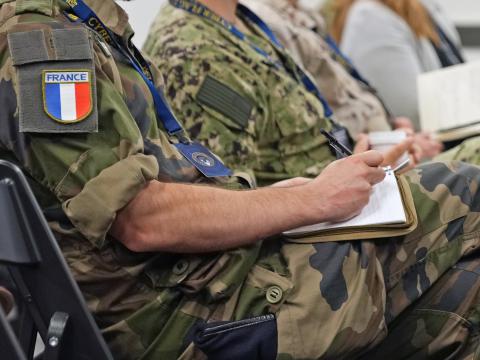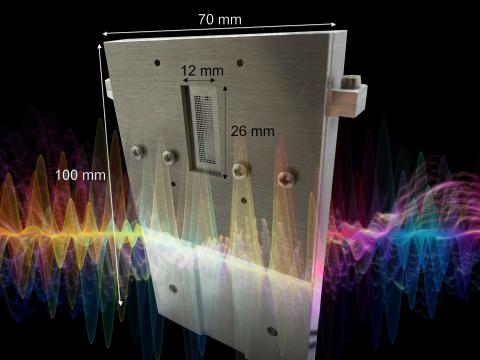 |
| The U.S. Army’s 7th Signal Brigade conducts a demonstration with the lightweight high-gain X-band antenna (LHGXA) in Mannheim, Germany. The tests linked the XTAR-EUR satellite with extremely high data rates over the LHGXA, which provides a 16-foot-diameter reflector mounted on a towable trailer. This antenna has the equivalent performance of a 20-foot-diameter reflector because of its shaped offset feed design. |
Steerable spot beam coverage connects troops with critical command and control information.
A new high-power commercial X-band communications satellite, designed to meet growing bandwidth demands, will help satiate the U.S. military’s voracious appetite for space-based connections. Rapidly increasing satellite communications requirements are expected to continue outstripping government-owned satellite capacity for the foreseeable future.
Called XTAR-EUR, this satellite with its greater bandwidth and higher power capability allows U.S. forces and other users to move their X-band spot beam coverage over any distance required in real time. The spacecraft is structured to interface with all current inventories of X-band terminals without the need for additional infrastructure. XTAR’s onboard switching and stackable spot beams are capable of fulfilling large bandwidth requirements. When necessary, the satellite can focus substantial bandwidth in one location such as an active military theater.
During recent tests in Germany and Great Britain, the XTAR successfully proved its interoperability with existing U.S. Army and U.S. Air Force satellite terminals using standard modems. The XTAR-EUR test results were briefed in late August to U.S. combatant commanders meeting in CrystalCity, Virginia, making them aware of the spacecraft’s capability to augment tactical communications with minimal satellite antenna modifications.
The U.S. State Department also participated in the European-based military demonstrations at a separate site in Croughton, England, and already has contracted for XTAR use. Signed in early May, the indefinite delivery and indefinite quantity contract has a maximum value of $137 million over five years. Transponder allocation is by the Diplomatic Telecommunications Service Program Office (DTSPO), Fairfax, Virginia. This contract provides an established mechanism for the Defense Department and other U.S. government agencies to lease XTAR transponder capacity.
The DTSPO manages a worldwide communications network comprising government-owned and commercially leased assets for agencies that represent U.S. diplomatic posts abroad. An X-band commercial satellite network is being implemented by the DTSPO using government-owned earth terminals. There are 260 diplomatic sites around the world that represent some 50 U.S. agencies.
Financed privately, XTAR satellites are designed to provide customized communications services exclusively to U.S. and allied governments. The concept is to support military, diplomatic and security communications. Denmark, as an example, already is leasing the first left-hand circular polarizing capability on XTAR-EUR for use by its military. The satellite company manages transponder capacity for that nation.
XTAR began offering its capacity to customers in early 2005, following successful completion of in-orbit testing. XTAR-EUR’s satellite footprint reaches from eastern Brazil and the Atlantic Ocean, across all of Europe, Africa and the Middle East to as far as Singapore.
The satellite company, XTAR LLC, is a joint venture between Loral Space & Communications Limited and Spain’s HISDESAT Servicios Estratégicos, S.A. The Spanish Ministry of Defense is XTAR’s first customer, leasing 238 megahertz of capacity on XTAR-EUR until its own primary X-band satellite, SPAINSAT, enters service. When that occurs, XTAR-EUR will provide back-up capacity. SPAINSAT will operate from a geosynchronous slot at 30 degrees west longitude over the Atlantic Ocean.
In addition, XTAR LLC will lease eight 72-megahertz X-band transponders on SPAINSAT, designating them XTAR-LANT, to provide flexibility and additional services. Located at 29 degrees east longitude, XTAR-EUR offers a dozen 72-megahertz 100-watt transponders, two global beams, one fixed spot beam over Europe and four steerable spot beams, Dr. Denis J. Curtin explains. He is XTAR LLC’s chief operating officer.
“When XTAR-LANT is launched in early 2006, that satellite will carry eight 72-megahertz transponders, two global beams, one fixed beam over the United States and three steerable spot beams. The XTAR-LANT footprint will reach from Saudi Arabia to Denver, Colorado,” Curtin relates. With a 35-year career in satellite communications, he holds a bachelor’s and a master of science degree in physics and a doctorate in mechanical engineering from Catholic University, Washington, D.C.
Designed exclusively for government users, XTAR-EUR provides transponder bandwidth capacity for U.S. and allied forces in theaters of operation, Curtin points out. Built by Space Systems/Loral, XTAR-EUR was launched aboard an Ariane 5 ECA rocket from Kourou, French Guiana. SPAINSAT also is being built by Space Systems/Loral and is scheduled to be launched on an Ariane booster within four months.
Curtin credits the U.S. and Spanish governments for their cooperation with the satellite program. “The U.S. government supported XTAR from the embassy in Madrid and also approved the use of National Security Agency encryption on both satellites—the first time the encryption will be used by a non-English-speaking country. Indeed, the U.S. government also assisted in the coordination of satellite parking slots. The United States already had a satellite operating at 29 degrees east longitude with the possibility of subsequently adding an ultrahigh frequency (UHF) spacecraft at that location. However, the government agreed to move its existing satellite out of 29 degrees east once XTAR-EUR arrived in orbit. A further agreement calls for the government to handle any potential interference problems with XTAR and its ground segment, if a UHF satellite is moved into that geostationary position,” he explains.
 |
| An antenna feed prototype developed by Harris Corporation for use by the Army with its LHGXA successfully enables selectable X-band polarization. The feed prototype enables data rates of 105 megabits per second using the LHGXA and a modified AN/TSC-85C terminal operating over the XTAR-EUR satellite. |
Following extensive market research by Loral, it was determined that a very large number of legacy
X-band terminals were available to the government and military for immediate use. A new X-band satellite could exploit this terminal availability since the military relied on X-band heavily for the Defense Satellite Communication System (DSCS) prior to commercial satellite use, Curtin continues. However, the
U.S. government has not been willing to license X-band satellite operations to American companies.
“As part of an evolving market analysis process, we discovered that Spain was interested in putting up its own military satellite, and that it also wanted a backup capability for that satellite. With mutual interests, we discovered that Spain already had filed for and had been granted X-band satellite slots,” Curtin discloses. “Spain’s interest extended to forming a joint venture to put up another spacecraft that could provide backup and residual capacity on a commercial basis and provide revenue to support their system.”
As a result of the joint venture, XTAR LLC emerged with Loral owning 56 percent and HISDESAT 44 percent. XTAR’s headquarters are in Rockville, Maryland, with offices in Arlington, Virginia; Palo Alto, California; and Madrid. “HISDESAT’s aims are the acquisition, operation and commercialization of government-oriented space systems, beginning with X-band and Ka-band frequencies. HISDESAT is owned jointly by HISPASAT, S.A., the Spanish commercial satellite services company; INSA, which is 100 percent owned by the Spanish government; and leaders of Spain’s space industries: EADS-CASA, Espacio, INDRA and SENER,” Curtin clarifies.
“A Space Systems/Loral 1300 platform is being used with both the XTAR-EUR and SPAINSAT. XTAR-EUR, which has a specified service life of 15 years, maintains stationkeeping and orbital stability by using bipropellant and momentum-bias systems. The satellites are three-axis stabilized with deployed solar arrays. The XTAR-EUR spacecraft provides both right- and left-hand circular polarization. This feature often is used on commercial satellites but not on U.S. military or NATO spacecraft, which are right-hand circular polarized,” Curtin states.
XTAR LLC decided to use both right- and left-hand circular polarization technologies because as a business venture this technique provides a more capable satellite. The approach also is gaining increasing acceptance within the U.S. government. The Army already is expected to issue contracts to industry for modification of legacy terminals with field installation kits, Curtin remarks. “New production terminals will be delivered with both right- and left-hand circular polarization capabilities,” he stresses. “The military would not commit to use the satellite’s transponders until their terminals successfully had undergone testing with XTAR-EUR. This was accomplished during the first test in Mannheim, Germany, in June, followed in July with tests at Ramstein Air Force Base, Germany.”
In the Mannheim tests conducted by the Army’s 7th Signal Brigade, a 16-foot-diameter dish antenna was used with a modified antenna feed, Dennis Evanchik says. An 8-foot-diameter tactical satellite antenna and related system components also were tested. Based at Fort Monmouth, New Jersey, Evanchik is the project leader for the Army’s lightweight high-gain X-band antenna (LHGXA) and served as the Mannheim test director. “A series of interoperability demonstrations with both a standard and modified LHGXA feed assembly accessed the new XTAR-EUR X-band satellite. Using the standard modem currently installed in the AN/TSC-85C tactical satellite (TACSAT) van, a datalink of 8 megabits per second was established immediately.
“Harris Corporation, Melbourne, Florida, manufactures the LHGXA antenna, and along with L3 Communications Systems–West, Salt Lake City, provided modified antenna feeds. The feeds allowed 25-year-old terminals to use both the right- and left-hand circular polarizations available on the XTAR-EUR satellite,” Evanchik stresses. “Harris, using corporate research and development funding, modified the right-hand circular polarization feed. A rotary coupling was installed to allow 90 degrees of feed rotation. This rotation changed the standard right-hand configuration to a left-hand arrangement.”
L3 Corporation also used company funding to modify a standard AS-3036A right-hand feed to allow 90 degrees of feed rotation. The modification allows operation over XTAR-EUR in both right- and left-hand configurations. L3 also supplied a new model AMT-73L modem from Advantech AMT of Phoenix, and Dorval, Quebec, the same modem to be installed in the PHOENIX Block 2 upgrade. The Army’s PHOENIX satellite terminal provides quad-band (C, X, Ka and Ku) capability in the super high frequency range. This modem was later used in the demonstration at data rates in excess of the current L3 model 3501 modem, installed in the AN/TSC-85C TACSAT van.
“After installation of the new modem, stable data rates were in excess of 105 megabits per second while using less than 10 percent of satellite transponder power and 20 watts of terminal power when operating within the satellite’s spot beam,” Evanchik says. Despite the age of the terminals, engineers were able to transmit high data rates reliably over the satellite using 40 megahertz of bandwidth at quadrature amplitude modulation and Reed-Solomon forward error correction coding.
“We took conventional satellite communications equipment and an LHGXA terminal that had been in the field for many years and only modified two pieces of equipment—the XTAR-EUR feed, and installed a new modem in the van, replacing a 20-year-old design with the new PHOENIX modem for Army commonality. The tests were extremely successful—so much so that all new LHGXA systems will be built with XTAR capability for both right- and left-hand circular polarization. This is a product enhancement at minimal cost,” Evanchik reveals. “We are positioning for the future.”
The smaller USC-60A 8-foot-diameter antenna achieved stable data rates in excess of 75 megabits per second using less than 21 percent of satellite transponder power and 370 watts of terminal power. “From our perspective, the XTAR tests were a success,” Evanchik asserts. “Minimal antenna upgrade was required to access the XTAR left-hand circular polarization; minimal hardware upgrade was necessary with the modem and a multiplexer; and the cost per bit is significantly lower than commercial leases with Ku-band. As demonstrated, data rates with X-band exceed current Ku-band capability, and we are no longer power-limited.”
The final report for the Ramstein demonstration was still being prepared at press time. However, according to Rick Dunnegan, the test director, overall, the XTAR-EUR satellite performed well using tactical military terminals. “The satellite is technically suitable where X-band may be required for inter-theater applications using two transponders,” he reports. Dunnegan is a test engineer at the JointSatelliteCommunicationsEngineeringCenter, FortMonmouth. “Gateway access and control aspects worked well overall using military terminals with a few exceptions.”
At Ramstein and Croughton both Army and Air Force terminals and antennas were employed. In Germany, two USC-60A terminals were used. This highly transportable 2.4-meter-diameter terminal is primarily in use for joint deployable intelligence support systems, operating in C-, X-, and Ku-bands. In England the LHGXA with its 16-foot-diameter antenna was used. “Overall, XTAR-EUR worked as advertised as a very high-power satellite using military assets. It doubles the capacity of DSCS,” Dunnegan maintains. “However, some inexpensive terminals did not have the proper isolation required for XTAR, while other existing terminals in the inventory for years provided very good isolation.”
The State Department successfully conducted XTAR tests at a separate Croughton location using an SC-6 Enterprise terminal and a 66-foot-diameter dish antenna. U.S. Air Force terminals at the Croughton standard tactical entry point are focused on DSCS and were connected for the test to the SC-6 via fiber optic cable.
The Air Force will make a decision on whether to participate with XTAR-EUR based on the demonstration results in the final report, Col. Christopher L. Moore, USAF, says. He is deputy director of the Global Communications and Information Directorate, Air Force Command and Control, Intelligence, Surveillance and Reconnaissance Center (AFC2ISRC), Langley Air Force Base, Virginia. The reason, Col. Moore explains, is the left-hand circular polarization requirement with military terminals. “They are not set up to handle both right- and left-hand polarization. Without knowing the technical results of the test, there could be interference issues with the opposite transponder that may reduce efficiencies or gains in bandwidth.
“But let me be clear; I’m very happy with what we have heard thus far, with respect to the test. XTAR gives us some increased flexibility in an extremely bandwidth-constrained environment that we work and fight our wars in today. However, I’m hesitant to say we had a fully successful demonstration without final test results, which could cause us not to pursue XTAR,” the colonel says. Adding that funding is tight, “the bill we may have to pay to make our legacy terminals compatible with this capability could be too high,” he continues.
Master Sgt. Tobey T. Sizemore, USAF, was the Ramstein demonstration point of contact for AFC2ISRC. He adds, “XTAR was tested in an unprecedented way.” The sergeant is the satellite communications programs superintendent for AFC2ISRC. “Without a doubt, there is increased capacity due to the improved power available on this commercial satellite. Still, there are some concerns with legacy terminals but not with all of them. The increases in power, whether on XTAR or the follow-on UHF wideband gap filler military satellites, will provide increased capacity to disadvantaged tactical terminals. And we successfully demonstrated that with some caveats. We wholeheartedly think that XTAR could provide an interim capability until the UHF comes along in a couple of years.”
Web Resources
Loral Space & Communications Limited: www.loral.com
XTAR LLC: www.xtarllc.com





